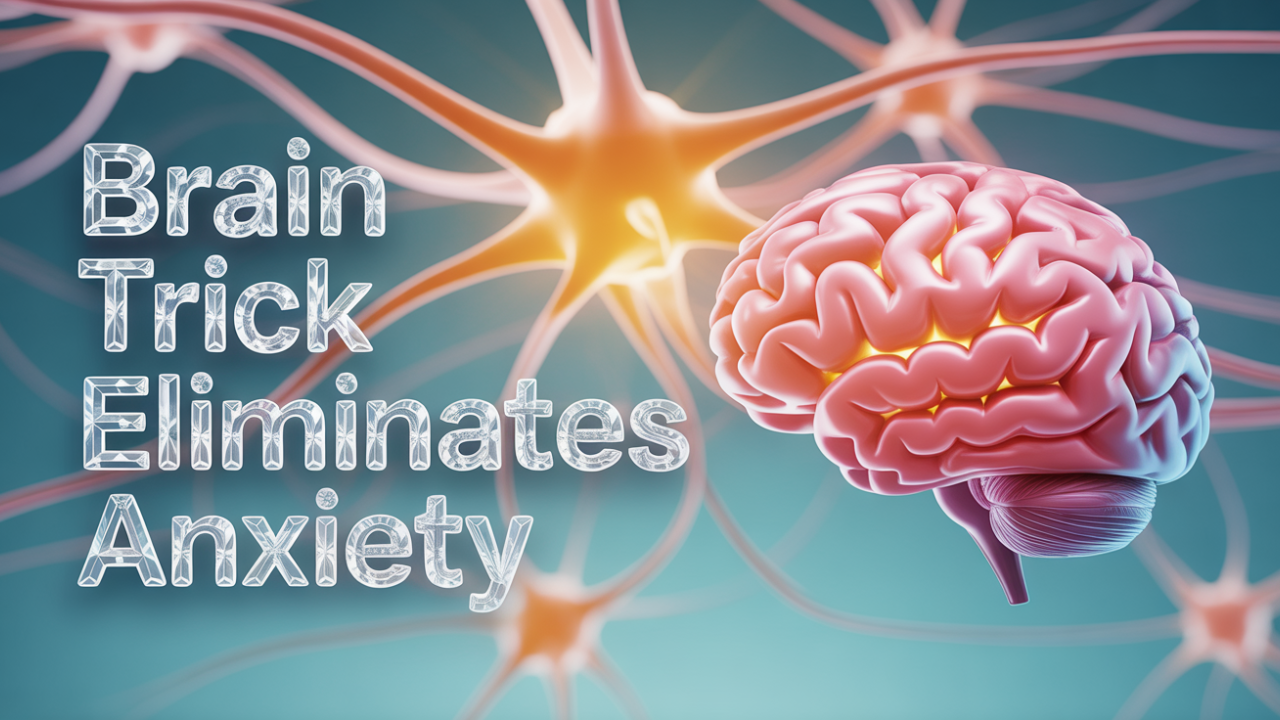### **Hook**
Do you feel anxiety? Does your mind ever feel like a noisy room you can’t escape? That constant, looping soundtrack of ‘what ifs’ and worst-case scenarios that just buzzes behind your eyes, leaving you drained and powerless? You try to focus, you try to relax, but the noise just gets louder. It’s easy to start thinking that this is just… you. A permanent part of who you are.
But what if I told you that noise isn’t your identity? That it’s not a life sentence? Science has shown us that you can physically change your brain, quiet that noise, and reclaim your focus. In this video, I’m going to share five simple, science-backed exercises you can do at home to start rewiring your brain for quiet and focus, starting today.
### **Section 1: The Trap of the Anxious Brain**
Before we get to the “how,” it’s so important to understand the “what.” What is actually happening in your head when that storm of anxiety hits? A lot of people live with it for so long they forget what it even feels like to be without it. It just becomes their normal. But it isn’t.
What you’re experiencing is often called the “anxiety cycle.” It’s a powerful, self-feeding loop that can feel impossible to break. It all starts with a trigger. This could be anything—an email from your boss, an upcoming party, or even just a random, intrusive thought that pops up out of nowhere.
That trigger sparks an anxious thought. “I’m going to get fired.” “Everyone will think I’m awkward.” “What if something terrible happens?” These thoughts aren’t gentle suggestions; they’re loud, demanding alarms that feel incredibly real and urgent.
This mental alarm then sets off a physical response. Your heart starts to pound. Your palms get sweaty. You might feel a tightness in your chest or a knot in your stomach. This is your body’s ancient fight-or-flight system kicking into high gear, flooding you with stress hormones like adrenaline and cortisol. Your brain’s fear center, a small almond-shaped area called the amygdala, is now screaming “DANGER!”
And here’s the cruel twist: your mind then sees these physical sensations as proof that the anxious thought was right all along. “My heart is pounding, so there must be a real threat. I *am* in danger.” This confirmation makes the anxious thought even stronger, which amps up the physical feelings, which validates the thought even more. Round and round it goes. You’re caught in a spiral where thoughts and feelings feed each other, getting more intense every time.
Living like this is completely exhausting. It’s like running a marathon every single day without ever reaching a finish line. This constant state of high alert drains your mental and physical batteries, leaving you irritable, unable to concentrate, and always on edge. Over time, it can lead to a deep sense of helplessness. You start to believe this anxiety isn’t just something you feel, but something you *are*. “I’m an anxious person.” The thought patterns get so automatic, so deeply wired, that you can’t imagine a world where they don’t run the show. You feel stuck, defined by the very thing you want to escape.
This is the trap of the anxious brain. It’s a prison built from your own thoughts and feelings. But what science has shown us, with incredible clarity, is that you hold the key to taking this prison apart, brick by brick. You have more power than you realize. And that power is called neuroplasticity.
### **Section 2: The Science of Hope: What is Neuroplasticity?**
For a long time, scientists believed the adult brain was basically fixed. The idea was that by your early twenties, the wiring was set in stone. Your personality, habits, and emotional reactions were carved, and you just had to live with them. This was pretty discouraging, especially for anyone struggling with something like anxiety. It suggested that you could only manage symptoms, not actually change the source of the problem.
But in the last few decades, a revolution in neuroscience has flipped that old idea on its head. We now know the brain isn’t a static machine. It’s a dynamic, living organ that is constantly adapting. This amazing ability of the brain to reorganize itself, to form new connections and let old ones fade away based on our experiences, thoughts, and actions, is called neuroplasticity.
Think of your brain as a dense forest. When you think a thought or do something new, it’s like hacking a new path through the undergrowth. It’s slow and takes a lot of conscious effort. But if you walk that same path every day, the trail gets clearer. Over weeks and months, it becomes a well-worn path. After years, it might even turn into a paved superhighway. It becomes automatic.
When you live with chronic anxiety, you’ve unintentionally walked the same fearful, worried paths over and over. Anxious thoughts and worst-case scenarios have created superhighways in your brain. These neural pathways are so strong that the slightest trigger can send your thoughts speeding down them, launching you into an anxiety cycle before you even know what’s happening.
This process involves a few key players in the brain. We’ve talked about the amygdala, your brain’s alarm system. In an anxious brain, the amygdala is often hyper-reactive, like a smoke detector that goes off every time you make toast. At the same time, the prefrontal cortex—the part of your brain for rational thinking and emotional regulation—can become underactive. It’s supposed to be the calm adult in the room that tells the amygdala, “Hey, it’s just toast, stand down.” But in the anxious brain, that connection can weaken. The alarm is screaming, and the adult can’t be heard over the noise.
Neuroplasticity is the science of hope because it proves these pathways aren’t permanent. You can let the old, anxious superhighways get overgrown from disuse, and you can start forging new, calmer paths. This isn’t just a metaphor; it’s a physical reality. Studies show that consistent mental practice can physically change the brain’s structure. For example, some research suggests that regular meditation can lead to a decrease in the gray matter density of the amygdala, which could effectively turn down the volume on the brain’s alarm system. It can also strengthen the prefrontal cortex and its connection to the amygdala, improving your brain’s ability to regulate itself.
The most famous example of this is the study of London taxi drivers. To get their license, they have to memorize “The Knowledge”—the impossibly complex layout of 25,000 streets. Brain scans showed that these drivers have a much larger hippocampus, a brain area vital for memory, than the average person. Their brains physically changed to meet the demands of their job.
What this means for you is huge. It means anxiety is not a fixed part of you. It’s a learned habit of the brain. And just like habits can be learned, they can be unlearned. Through conscious, intentional practice, you can become your own brain-sculptor. The exercises we’re about to cover are the tools you’ll use to build new roads in your brain—roads that lead not to fear, but to quiet and focus.
### **Section 3: The Foundation – Separating Yourself from the Noise**
Before we jump into the exercises, we need to lay a foundation. It’s a mental shift that makes all the other techniques way more powerful. The shift is this: **You are not your anxiety. You are not your thoughts.**
This sounds simple, but it can change everything. For years, you’ve likely fused your identity with the anxious chatter in your head. When a worried thought pops up, you instinctively grab onto it and believe it. “I am anxious.” “I am a worrier.” This fusion is what gives the thoughts their power. It’s like letting a heckler from the audience jump on stage, grab the mic, and pretend to be the star of the show.
The first step to rewiring your brain is to create space between you—the observer—and the storm of your thoughts. You have to learn to see your anxious thoughts not as facts, but as events happening in your mind. They are temporary, fleeting bits of data generated by an overactive part of your brain.
Dr. Jeffrey Schwartz, a research psychiatrist, developed a powerful four-step method for this. The first and most important step is to **Relabel**.
Relabeling means calling the thought what it actually is: a symptom. An automatic, deceptive brain message. It’s not some deep truth about reality; it’s a glitch in the system, a misfire from an old, overused circuit.
So, the next time the thought “What if I make a fool of myself at this party?” pops into your head, instead of getting swept away by it, you pause. You take a mental step back. And you relabel it. You can say to yourself, “Okay, that’s an anxious thought.” Or, “That’s my brain doing its ‘what if’ thing again.” Or even, “That’s a junk message from my hyperactive amygdala.”
This simple act of labeling changes your relationship to the thought. You are no longer *in* the thought; you are the one *noticing* the thought. You’re no longer being swept down the river; you’re standing on the bank, watching the water go by. This gives you a moment of choice.
Dr. Schwartz’s second step is to **Reattribute**. This builds on relabeling. You remind yourself *why* this thought feels so real and urgent. You say, “This feeling of panic isn’t because the thought is true. It’s because my brain is stuck in an old anxiety loop. It’s just a faulty circuit.” By reattributing the cause, you strip the thought of its power. You recognize that its intensity comes from brain mechanics, not reality.
This one-two punch of Relabel and Reattribute is the bedrock of changing your brain. You’re stepping into the role of a compassionate observer of your own mind. You’re not fighting the thoughts or trying to shove them away—because what you resist, persists. Instead, you’re just seeing them clearly for what they are: impersonal, automatic, and ultimately, meaningless noise.
### **Section 4: The Brain Rewiring Toolkit: 5 Science-Backed Exercises**
Okay, now we get to the practical tools. These five exercises are your toolkit for actively building new, calm neural pathways. Remember, consistency is way more important than intensity. Doing this for a few minutes every day will do far more for you than one heroic two-hour session. This is about building habits that will serve you for life.
#### **Exercise 1: Focused Attention (The Quiet Anchor)**
The first exercise is a form of mindfulness meditation called Focused Attention. If anxiety is a chaotic storm, this is how you drop an anchor into the calm, quiet depths below. The goal isn’t to stop your thoughts—that’s impossible. The goal is to practice gently redirecting your attention, over and over, to a single, neutral anchor point.
**The Science:** Every time you notice your mind has wandered and you gently bring it back to your anchor (like your breath), you are doing one mental “rep.” This rep strengthens your prefrontal cortex, the part of your brain for focus and emotional regulation. At the same time, it helps calm the hyperactive amygdala. Research consistently shows that regular meditation can physically change these brain regions, making you less reactive to stress. You are literally training your brain to be less anxious.
**How to Practice:**
**Get comfy.** Sit in a chair with your feet on the floor, or on a cushion. Sit up straight but not stiff. You want to be alert but relaxed.
**Set a timer.** If you’re new to this, start small. Five minutes is perfect. It’s better to do five minutes every day than to aim for twenty and then quit.
**Choose your anchor.** The breath is the most common anchor. It’s always there. Close your eyes or just soften your gaze. Start to notice the physical sensation of breathing. Don’t change it, just feel it. Feel the air at the tip of your nose, or feel your belly rise and fall.
**Your mind *will* wander.** This is not a failure. It’s just what minds do. You’ll think about your to-do list, a conversation, anything. The moment you realize your mind has wandered—that “aha” moment—is the most important part of the whole practice.
**Gently return.** When you notice you’ve wandered, gently and without any judgment, just guide your attention back to your breath. That’s it. You’ll do this dozens of times. Every single return is a successful rep for your brain. The key is to be kind to yourself. The practice *is* the act of returning, again and again.
### **Mid-Roll CTA**
By the way, if you’re finding these techniques helpful and starting to see how change is really possible, I’d love for you to subscribe to the channel. We go deep into the practical science of mental well-being every week. And if you want even more insights and exercises sent right to your inbox, you can sign up for my weekly newsletter. The link is right down in the description.
#### **Exercise 2: Cognitive Reframing (The Story Editor)**
Anxiety is a master storyteller. It takes a tiny, neutral fact and spins it into a terrifying disaster story. Cognitive Reframing is the practice of becoming the editor of those stories. It’s a key part of Cognitive Behavioral Therapy (CBT), a gold-standard treatment for anxiety, and it directly targets the faulty thought patterns that keep the anxiety cycle going.
**The Science:** This exercise works by creating and reinforcing new, more balanced neural pathways. When you challenge an automatic negative thought and consciously choose a more realistic one, you start carving that new trail in the forest of your brain. With practice, the new path becomes stronger and more automatic.
**How to Practice:**
Let’s use a common example: You send an important email, and hours pass with no reply. The anxiety story starts: “They’re mad. I messed up. I’m going to lose this client.”
**Step 1: Relabel.** The moment you feel that anxiety, you label the thought. “This is a catastrophic thought. It’s an anxiety symptom, not reality.”
**Step 2: Reattribute.** Remind yourself why it feels so strong. “This dread is from my sensitized anxiety pathways. It’s a false alarm.”
**Step 3: Reframe (Challenge & Replace).** Now, you edit. Become a gentle detective. Ask yourself:
What’s the *evidence* for this thought? (The only evidence is that they haven’t replied.)
What’s the evidence *against* it? (They could be busy. They might be in meetings. I’ve had a good relationship with them. There are dozens of other, more likely reasons.)
What’s a more balanced, realistic way to see this? (“It’s likely they just haven’t seen my email yet. I’ll wait until tomorrow, and if I don’t hear back, I’ll send a polite follow-up. There is no evidence of a problem right now.”)
**Step 4: Refocus.** This is key. After you reframe, you must shift your attention to something else. Get up and walk around. Work on another task. Call a friend. This tells your brain, “That anxious thought isn’t important. *This* is important.” You’re starving the anxiety of the attention it needs to survive.
#### **Exercise 3: Deep Breathing (The Vagus Nerve Reset)**
This is probably the most immediate tool in your kit. While other exercises work on your mental software, this one works directly on the hardware of your nervous system. Anxious breathing is shallow and rapid. By intentionally changing your breath, you send a powerful signal of safety straight to your brain.
**The Science:** Slow, deep belly breathing activates the “rest and digest” system, which is the body’s natural antidote to “fight or flight.” Specifically, it stimulates the vagus nerve, a huge nerve running from your brain down to your abdomen. Stimulating this nerve is like hitting a reset button; it slows your heart rate, lowers blood pressure, and tells your body it’s safe to calm down. One of the most studied methods is the 4-7-8 breath.
**How to Practice the 4-7-8 Breath:**
Popularized by Dr. Andrew Weil, this is incredibly simple.
Sit up or lie down. Place the tip of your tongue on the ridge of tissue right behind your upper front teeth.
Exhale completely through your mouth with a whoosh sound.
Close your mouth and inhale quietly through your nose for a count of **four**.
Hold your breath for a count of **seven**.
Exhale completely through your mouth with a whoosh sound for a count of **eight**.
That’s one breath. Repeat the cycle three more times, for a total of four breaths.
The long exhale is the most important part; it’s what really engages that “rest and digest” system. You can use this in the middle of a stressful moment, or practice it daily to keep your nervous system regulated.
#### **Exercise 4: The 5-4-3-2-1 Grounding Technique (The Present Moment Snap)**
Anxiety almost always lives in the future—in the land of “what if.” The 5-4-3-2-1 technique is a powerful tool to pull your mind out of that imagined future and plant it firmly in the real, solid present moment. It’s like an emergency brake for a racing mind.
**The Science:** When you’re anxious, your focus is turned inward on a loop of fearful thoughts and feelings. This technique forces your attention outward. By methodically using all five senses to scan your environment, you activate different parts of your brain and calm the amygdala. It breaks the anxiety loop by giving your brain a simple, concrete task.
**How to Practice:**
You can do this anywhere, anytime. When you feel that wave of anxiety rising, just pause.
**5 – SEE:** Look around and name **five** things you can see. Notice details. The specific shade of blue of a pen. The way light hits a glass. The texture of a book cover.
**4 – FEEL:** Name **four** things you can feel. The softness of your shirt. The solid ground under your feet. The cool surface of your table. The weight of your phone in your hand.
**3 – HEAR:** Listen carefully and name **three** things you can hear. The distant traffic. The hum of a refrigerator. The sound of your own breathing.
**2 – SMELL:** Name **two** things you can smell. The faint scent of coffee. The clean smell of the air. If you can’t smell anything, just notice the feeling of air in your nostrils.
**1 – TASTE:** Name **one** thing you can taste. The lingering flavor of your last drink, or just the neutral taste inside your mouth.
Take a deep breath. You’ll likely notice the volume on the anxiety has been turned down. Your mind feels clearer, more settled in the here and now.
#### **Exercise 5: Positive Visualization (The Future Architect)**
This final exercise uses the brain’s incredible inability to tell the difference between a vividly imagined event and a real one. Visualization isn’t just wishful thinking; it’s a mental rehearsal that can build new neural pathways for confidence and calm.
**The Science:** When you vividly imagine yourself successfully handling a situation that makes you anxious, your brain activates many of the same neural circuits as if you were actually doing it. By repeatedly rehearsing a positive outcome, you’re pre-paving a new road. Instead of your brain defaulting to the old “panic” pathway, you’ve created a new, “I’ve got this” pathway. This reduces the anticipatory anxiety, which is often the worst part.
**How to Practice:**
Let’s say you have a job interview coming up.
Find a quiet space for 10-15 minutes.
Take a few 4-7-8 breaths to calm your body and mind.
Create the scene in your mind. Don’t just think about it; *experience* it. See the room. Hear the calm, confident sound of your own voice. Feel the comfortable chair beneath you.
Imagine it going well. See yourself shaking hands firmly. Imagine answering a tough question clearly and calmly. Imagine feeling nervous, but handling it with grace. This is important—don’t imagine having no nerves, but imagine yourself managing them competently.
Feel the emotions. This is the crucial part. As you visualize success, let yourself feel the pride, relief, and confidence. Let those positive feelings fill you up. Anchoring the image to a positive emotion is what cements the new neural pathway.
Repeat this daily leading up to the event. Each time, you’re making the “success” pathway more familiar to your brain. When the day comes, your brain will have a new script to follow—one that you wrote yourself.
### **Section 5: Making it Stick: Consistency is Key**
You now have a powerful set of tools. But a toolkit is useless if it just sits there collecting dust. The secret to making neuroplasticity work for you isn’t just knowing this stuff, but doing it. Consistently.
Think of it like going to the gym. You wouldn’t expect to have a six-pack after one workout. It’s the same principle for building new neural pathways. It’s a marathon, not a sprint. The changes can start happening within weeks, but the real, lasting transformation comes from steady, long-term practice.
So how do you make it stick?
First, be patient and kind to yourself. There will be good days and bad days. That’s normal. On the tough days, don’t give up. Just do one small thing. Do one round of 4-7-8 breathing. Name three things you can see. Every small effort is a vote for your new, calmer brain.
Second, weave these practices into your life. Don’t wait for an anxiety attack. Schedule five minutes of Focused Attention into your morning. Do the 5-4-3-2-1 technique while you’re waiting in line for coffee. Proactive practice builds those resilient pathways so they’re strong when you really need them.
Finally, mix and match the techniques. They work even better together. Use deep breathing to calm your body *before* you do a Positive Visualization. Use Relabel and Reattribute when a thought distracts you during your meditation. They are all different tools for the same job: taking back control of your inner world.
This journey isn’t about becoming someone else. It’s about clearing away the static and the noise so that the real you—the calm, focused, and capable you that’s been there all along—can finally come through.
### **Conclusion & CTA**
We’ve seen how the anxious brain can get stuck in a painful cycle of fear. But more importantly, we’ve learned that you are not stuck. Through the incredible power of neuroplasticity, you can physically change your brain.
You now have a toolkit to start that process: using **Focused Attention** to build your focus, **Cognitive Reframing** to rewrite anxious stories, **Deep Breathing** to calm your body, the **5-4-3-2-1 Technique** to ground you in the present, and **Positive Visualization** to build a blueprint for a confident future.
Remember, every time you practice one of these exercises, you’re casting a vote for a new way of being. You are taking an active role in your own healing. You have the power to silence the noise.
If this video gave you a new perspective on anxiety and a sense of hope, please subscribe to the channel and hit the notification bell so you don’t miss what’s next. We explore practical, science-based strategies for your mind every single week.
And now, I’d love to hear from you. Which one of these exercises are you going to try first? Leave a comment below. Sharing your journey can be a huge encouragement, not just for you, but for everyone on this same path. Thanks for watching, and remember, change is always possible.





